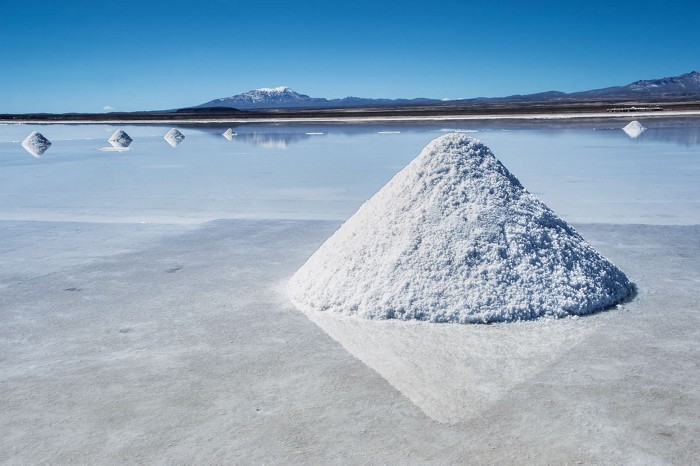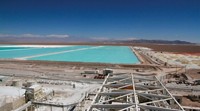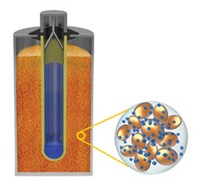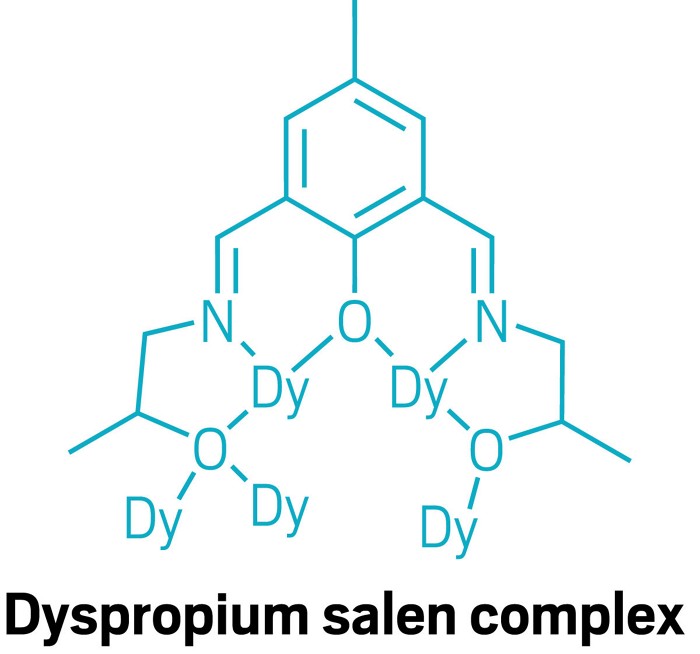Advertisement
Grab your lab coat. Let's get started
Welcome!
Welcome!
Create an account below to get 6 C&EN articles per month, receive newsletters and more - all free.
It seems this is your first time logging in online. Please enter the following information to continue.
As an ACS member you automatically get access to this site. All we need is few more details to create your reading experience.
Not you? Sign in with a different account.
Not you? Sign in with a different account.
ERROR 1
ERROR 1
ERROR 2
ERROR 2
ERROR 2
ERROR 2
ERROR 2
Password and Confirm password must match.
If you have an ACS member number, please enter it here so we can link this account to your membership. (optional)
ERROR 2
ACS values your privacy. By submitting your information, you are gaining access to C&EN and subscribing to our weekly newsletter. We use the information you provide to make your reading experience better, and we will never sell your data to third party members.
Inorganic Chemistry
Can seawater give us the lithium to meet our battery needs?
To harvest lithium from the oceans, chemists are developing methods that can isolate the element from dilute solutions filled with chemically similar elements
by Mitch Jacoby
September 28, 2021
| A version of this story appeared in
Volume 99, Issue 36

Lithium might seem wimpy, with its ultralow density and tiny mass. But element number 3 ranks as a technological heavyweight. The alkaline metal’s electrochemical properties coupled with its low weight make lithium ideal for use in batteries. Lithium batteries have turned the world upside down because they are powerful and pack a lot of energy into a relatively small and light device. They put the “portable” in portable electronics, and they are driving electric vehicles’ explosion in popularity.
Lithium by the numbers
▸ ~200 billion: Metric tons of lithium in oceans
▸ 21 million: Metric tons of land-based Li available now via standard mining methods
▸ 180 ppb: Li concentration in seawater
▸ 60,000:1: Ratio of Na to Li in seawater
Sources: US Geological Survey, Joule.
The growth in lithium batteries is happening so quickly that manufacturers are on track to consume one-third of the world’s land-based lithium in the next few decades, according to market analysts. With lithium in short supply on land and concentrated in just a handful of countries, researchers are looking for ways to mine the element from the oceans, which collectively hold 5,000 times as much lithium as that found on land.
But efficiently harvesting lithium from seawater presents a chemical challenge: How do you isolate one type of ion from a dilute solution containing many ions that are chemically similar and far more abundant?
Worldwide, manufacturers use more than 160,000 metric tons of lithium minerals annually. In 2020, 71% of that material was used to make batteries, according to data from the US Geological Survey (USGS). That’s up from 23% in 2010, when the main applications for lithium were glass and ceramics.
And the amount of lithium used globally is expected to rise sharply. According to the International Energy Agency, the number of electric passenger cars on the world’s roads topped 10 million in 2020, roughly double the number reported just 2 years earlier. That number continues to climb rapidly as countries pursue climate change policies that include moving away from petroleum-powered automobiles. Industry analysts predict that within 20 years, the majority of new light-duty vehicles will be battery powered. Other applications driving demand for lithium are batteries used by electric utility grids to store solar and wind energy.
Currently, lithium is mined on land. Estimates of the total amount of lithium in terrestrial sources vary widely because of differences in the way supplies of natural resources are tallied. Brian W. Jaskula, a minerals commodity specialist at the USGS, explains that the world’s reserve of lithium, meaning “the amount immediately and economically available by today’s extraction methods,” stands at roughly 21 million metric tons (t). The USGS’s estimate climbs to 86 million t when the tally includes supplies of lithium that could potentially be mined in the near term, he adds. The difference reflects findings from extensive geological surveys in Bolivia, Chile, Australia, and other countries, in response to growing demand for the lightweight metal.

Today’s commercial methods for mining lithium include extracting the metal from briny lakes and underground sources of concentrated salt water. Producers pump subsurface brine into large evaporation ponds and let it sit for a year or two, as sunlight slowly evaporates the water and concentrates the salts. They eventually treat the brine chemically to precipitate lithium carbonate, then filter and dry the mineral. That method is less expensive than the other common industrial method—extracting the metal from lithium-bearing mineral ores.
“Both production methods are rather polluting,” says Stanford University’s Steven Chu, a physics Nobel laureate who served as US energy secretary in the Barack Obama administration. Ore mining, which involves digging up and pulverizing rock and ore, then heating and treating the ore with acid, generates mounds of waste rock and acid by-products. Recovering the metal from brine consumes a lot of water, generates salt waste, and can contaminate water used for drinking and irrigation. Pushing producers to mine lithium in more environmentally friendly ways has been slow. One major reason for the slow pace is that “extracting lithium in an environmentally responsible way adds cost to the operation,” Chu says. So demanding that companies adopt less polluting methods can backfire, driving production to countries that are not vigilant about enforcing antipollution measures, he adds.
With demand for lithium on the rise, researchers are eyeing the oceans, which hold vast quantities of the metal—upward of 200 billion t by some estimates. Methods to harvest the metal from seawater might also be more environmentally friendly than current mining techniques.
“The problem is it’s incredibly dilute—about 180 parts per billion,” says Stanford University materials scientist Yi Cui. And lithium isn’t the only ion in seawater, or even the most common one: its presence is dwarfed by other ions, including sodium, a chemically similar monovalent ion present in the oceans at over 60,000 times the concentration of lithium.
To try to overcome these barriers to isolating lithium in seawater, researchers have turned to electrochemical methods, using battery-like setups and materials that selectively take up or transport lithium ions from dilute sources and concentrate the metal for recovery via precipitation.
For example, Chu, Cui, and coworkers are using lithium iron phosphate, a common Li-ion-battery cathode material that does its job in batteries by intercalating lithium ions in its crystal lattice. The team removes the lithium from the material, creating ion vacancies in the crystal structure. To boost the cathode’s selectivity for lithium over the far-more-abundant sodium, they coat it with a thin layer of titanium dioxide. The layer acts as a barrier, Cui explains, that enables the smaller lithium ions to sneak through while blocking sodium ions, which are larger. Lithium’s small size not only favors its uptake in the electrode relative to sodium but also gives lithium a mobility advantage, which enhances its diffusion toward the electrode, says Chong Liu, a materials scientist at the University of Chicago who worked on the study when she was a Stanford postdoc. Also favoring lithium is its stronger attraction to oxygen atoms in the electrode lattice.

To harvest lithium with this electrode, the Stanford scientists cycle the voltage applied to it. In a recent test, they immersed the electrode in a water sample from California’s Half Moon Bay with a Li-ion concentration of roughly 180 ppb (180 µg Li/kg seawater) and pulsed the electrode with a negative voltage to attract positive lithium ions. The process also attracted sodium ions, but relatively few. They then briefly turned off the voltage, withdrew the electrode, inserted it in fresh water, and reversed the voltage, driving the accumulated ions into the fresh water. After repeating the process 10 times, which took just minutes to complete, the team ended up with a one-to-one ratio of lithium to sodium. When the group applied the method to water collected from Utah’s Salt Lake, which contains a higher concentration of lithium—roughly 21 ppm (21 mg Li/kg seawater)—they boosted the Li-to-Na ratio to 50 to 1. The Stanford group estimates that the cost of electricity for Li extraction with the reported setup is $2 per kilogram (Joule 2020, DOI: 10.1016/j.joule.2020.05.017).
Zhen Li, Zhiping Lai, and coworkers at King Abdullah University of Science and Technology took a different approach to mining lithium from the sea. They used a lithium-conducting solid-electrolyte membrane and designed a continuously running, electrically driven separation process to enrich the element in seawater samples collected from the Red Sea.
The membrane, an ultrathin glasslike material known as lithium lanthanum titanium oxide (LLTO), features lattice holes just large enough to enable lithium ions to pass through while blocking larger, more abundant ions, including sodium and magnesium. The group set up a three-chamber cell with an electrode in each of the end compartments and the LLTO membrane sitting in the central section, which is supplied with seawater.

Applying roughly 3 V to the cell drives Li ions through the LLTO membrane, producing Li-enriched water that collects in a side chamber. The researchers can feed this water back into the system for additional cycles to further concentrate the lithium. In its tests, the team quickly boosted the Li-ion concentration in the seawater samples by roughly 43,000 times, to over 9,000 ppm (9,000 mg Li/kg seawater). The team reports that the process exhibits a Li-to-Mg selectivity of around 450 million and yields lithium phosphate precipitate with a purity of over 99.9%. The researchers estimate that their system can extract 1 kg of lithium from seawater at a cost of $5 (Energy Environ. Sci. 2021, DOI: 10.1039/d1ee00354b). “Our process is quick, energy efficient, and scalable,” Lai says. “And the system runs continuously and is compact and easy to operate.”

Meanwhile, Hui Ying Yang and coworkers at Singapore University of Technology and Design developed a flow system that doesn’t involve a sorbent that needs to be replaced regularly. Their electrochemical cell operates similarly to a redox flow battery. The device consists of an anode for oxygen reduction, a cathode for oxygen evolution, and a manganese oxide electrode for concentrating Li ions. Applying a voltage to the cell forces Li ions into the MnO2 and releases the ions in the form of lithium hydroxide precipitate (ACS Mater. Lett. 2020, DOI: 10.1021/acsmaterialslett.0c00385).
Although multiple groups of researchers have devised ways to harvest lithium from the ocean, none of the methods are currently practical. “It’s technically possible to extract lithium from seawater,” Cui says. “But it’s all about cost. And currently it’s too high.” All these groups are working to improve their electrochemical systems by designing electrodes that withstand thousands of Li uptake-and-release cycles and require less electric current to run. But to be adopted on a large scale, extracting lithium from seawater also needs to become economically attractive. And that depends on the metal’s market price, which has gone up and down in recent years in response to increased demand and successful geological exploration for the element, respectively.
Still, the biggest challenge in devising a practical system for extracting lithium from the ocean is the metal’s ultralow concentration in seawater. There are many sources of salt-enriched water with high lithium concentrations, including salty lakes, brine used in geothermal power plants, and brackish water generated from oil and gas production. Some researchers have started to look at those sources as a more practical starting point than ocean water. “If the lithium concentration starts out 10–100 times higher, then electrochemical systems could be economically feasible,” Cui says.
For example, Jeyong Yoon and coworkers at Seoul National University tapped desalination concentrate, the salt-enriched by-product of desalination plants. In a uniquely large-scale study, the team used a continuously operated battery-like system with 14 pairs of silver and manganese oxide electrodes. The system processed 6 t of desalination concentrate per day, raising the concentration of the Li-enriched starting material by a factor of 1,800 (Environ. Sci.: Water Res. Technol. 2020, DOI: 10.1039/c9ew00756c).
The growing demand for lithium isn’t slowing, as the world begins to move away from petroleum-fueled vehicles to those powered by lithium batteries. “I am not rooting for lithium,” Chu says. “I’m rooting for substitutes for petroleum fuels. What I care about most is clean transportation.” But as long as lithium batteries are the best option, researchers will need to find new, sustainable ways to harvest the element. Chu says, “If lithium continues to be king of the hill—the best material for electric vehicle energy storage—you don’t want to be limited by the supply and cost of lithium.”
UPDATE
This story was updated on Oct. 7, 2021, to clarify the caption with the photograph of the Uyuni Salt Flat. Geological surveys of this flat in Bolivia suggest it contains a large amount of lithium, but it hasn’t produced much of the element to date.






Join the conversation
Contact the reporter
Submit a Letter to the Editor for publication
Engage with us on Twitter